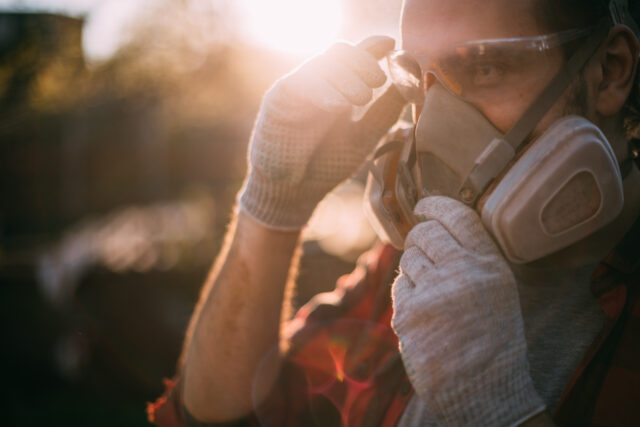In occupational health and safety, fit testing is critical, especially when workers are wearing respiratory protective equipment (RPE) like masks and respirators. The primary purpose of fit testing is to ensure that the chosen RPE forms an effective seal on the wearer’s face, minimising the risk of exposure to harmful airborne contaminants.
So, what is Face Fit Testing you may ask?
A face fit test evaluates how well an individual's respiratory mask fits on their face. This is to ensure the masks forms a secure, airtight seal, preventing the inhalation of airborne particles and contaminants. Fit testing is particularly critical for healthcare workers.
Are there different methods of Face Fit Testing?
There are 2 different types of fit testing. Qualitative and Quantitative.
A qualitative fit test is commonly done for half-masks and filtering face-piece respirators. The primary goal of qualitative fit testing is to determine whether the respirator forms a proper seal around the wearer’s face, preventing the ingress of harmful toxins.
This method of fit testing involves the use of test agents that challenge the seal of the respirator. These agents are substances with distinct odours or tastes. In the testing environment, these substances are introduced to see if the respirator can detect them.
The person undergoing fit testing will be wearing a hood. The hood captures the test agent around the person’s face during the test.
You will need to perform seven movements designed to simulate typical workplace activities. These exercises can include normal breathing, deep breathing, turning your head side to side, moving up and down, and also talking. In various conditions, these movements test the respirator's seal.
The wearer will be asked to report if they can taste or smell the test agent during the fit test exercises. If the wearer detects the test agent, it suggests a potential leak, and further adjustments, refitting, or a different respirator may be necessary.
Qualitative face fit test is a relatively simple and cost-effective method. However, this type of method relies on the wearer’s subjective response to the test agent, and it may not provide as precise results as quantitative fit testing methods.
Quantitative
Quantitative fit testing is a method used to objectively measure the effectiveness of the seal between a respirator and the wearer’s face. Unlike qualitative fit testing which relies on the wearer’s subjective response to the introduction of test agents, quantitative fit testing involves the use of specialised equipment to numerically measure the amount of leakage into the respirator.
The devices involved in quantitative fit testing measure the concentration of particles inside and outside the respirator, allowing for an objective assessment of the fit.
A challenge agent will be generated in the test chamber. The chamber simulates workplace conditions with airborne particles. Similar to qualitative fit testing the wearer performs a series of exercises that simulate different workplace movements and breathing patterns.
The fit testing equipment measures the concentration of particles both inside and outside the respirator during the fit test exercises. A fit factor is calculated by comparing the particle concentration inside and outside the respirator.
The fit factor obtained during quantitative fit testing is compared to established pass/fail criteria. If the fit factor meets or exceeds the specified criteria, the respirator is considered to have passed the fit test. If not, adjustments, refitting, or a different respirator may be necessary.
Quantitative fit testing is more objective and provides a numeric assessment of how well the respirator fits. It is suitable for situations where a more precise measurement is required. However,
Why is Face Fit Testing important?
People have different facial shapes and sizes, and respirators must fit each individual correctly to provide optimal protection. Fit testing helps identify the right respirator size and model for each person, ensuring a personalised and effective level of protection.
A proper seal is critical for the effectiveness of a respirator. Fit testing verifies whether the respirator forms a tight seal around the wearer’s nose and mouth, therfore preventing contaminated air from entering.
Fit testing can increase a workers’ confidence in the protective measures provided by their employers. This confidence is crucial for maintaining a positive safety culture and ensuring that employees feel secure in their work environment.
What to do before your fit test?
Before your fit test, you must follow the procedures:
- Don’t eat or drink within 30 minutes of your qualitative fit test, 60 minutes for a quantitative fit test (excluding unflavoured water).
- Don’t chew gum, smoke, or vape within 30 minutes of a qualitative fit test, 60 minutes for a quantitative fit test.
- Bring some form of photographic ID with you.
- Within the last 8 hours, ensure the mask seal area has been clean-shaven.
- Remove any make-up within the mask seal area.
- Have long hair tied back and out of the way.
- Bring any head worn personal protective equipment that you wear with your mask.
- Bring glasses if you wear them with your mask.
Fit testing is a critical process in ensuring the effectiveness of respiratory protective equipment. It plays a key role in protecting workers from airborne hazards, maintaining compliance with regulations, and also ensures a healthy work environment.
For more information on fit testing, please email enquiries@cavity-fit-test.co.uk or phone 0118 9079875.
